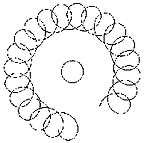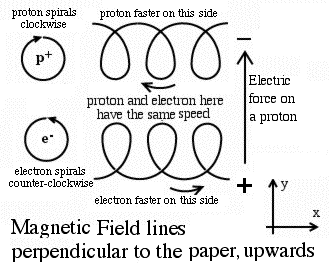-
The Electric Force
For the above reason, the local magnetic field lines in the drawing (repeated here for convenience) are assumed to be perpendicular to the paper, coming out towards you. Suppose also the electric field--representing the electric force--is in the plane of the drawing, towards the top of the figure. A straight arrow was drawn giving that direction, which we choose to be the y direction in a system of (x, y) axes, drawn in the bottom right corner.
A positive particle--such as a proton, marked here p+ --is pushed by the electric force towards the top of the drawing, in the +y direction.
A negative electron, marked e-, is pushed towards the bottom, in the -y direction You can imagine (if you wish) a positive charge somewhere below the drawing, and a negative charge somewhere above it, creating that force--repelling or attracting the
proton or electron.
- The Magnetic Force Alone
If the electron and the proton (or other positive ion) were free, they would simply move in those directions. But they are not free, because of the magnetic force.
If only magnetic forces were present (no electric field), the proton would circle around a magnetic field line in the clockwise direction (from where we are looking) and the electron in the counter-clockwise direction. These directions are given near the left edge of the drawing.
- Electric and Magnetic Forces together
The electric force modifies the motion. Protons are accelerated in the +y direction, so they move a bit faster on the part of their circle closer to the top of the page (see drawing above!).
Electrons are accelerated in the -y direction, so their speed is a bit greater on the
part of their circle closer to the bottom.
Faster ions or electrons circle with a bigger radius. They behave a bit like a racing car: the greater its speed, the wider is the circle it follows when going around a curve.
Therefore
protons make wider circles at the top of their circles, and
electrons make wider circles at the bottom of their circles.
This is shown in the drawing, and the result is a slow crablike sideways motion ("drift") in the (-y) direction, by both ions and electrons. Even though they circle their field lines in opposite directions, the electric field moves them both in the same direction, to the right.
It can also be shown that the velocity of both motions is always the same--even though protons are nearly 2000 times heavier, and even though the initial energies of the particles can be very different. (To those familiar with mathematics and physics, this process can be explained much more concisely and transparently.) The result is always a sideways flow of the plasma, a migration of the entire plasma, a bulk motion of the gas rather than a flow of electric current.
Barium Clouds and Solar Wind

Such an "electric drift" takes place in the barium cloud (section #8 whose figure is repeated here). The green cloud of neutral barium stays still, while any electric field present makes the purple cloud, consisting of ions and electrons, drift away from it (see illustration). Of course, since ions and electrons remain free to slide along magnetic field lines, the ion cloud also expands slowly in that direction (or rather, in two opposite directions--up and down the field lines).
Where can such electric fields come from? Probably from far out in space. As noted earlier on this web page, a magnetic field line tends to have the same voltage everywhere along its length. If an electric field is created anywhere on that line, its voltage will be transmitted to the rest of it, and with it, the electric field is also transmitted. Thus an electric field created far in space can spread to the end region of the line, where the line comes down into the atmosphere, and where the transmitted field causes barium clouds to drift.
--------------
Electric fields in space also arise in other ways. When some powerful cause "pushes" plasma to move in some direction, an electric fields helps achieve this. The positive and negative charges creating such a field need only a relatively small number of electrons to be moved to new positions, and where the impulse for moving the plasma is strong enough, nature obliges and shifts them. The motion of plasma--changing the magnetic field line structure--is also associated with an electric field, of a type which cannot be conveniently described by simple voltage distributions.
--------------
One example is the solar wind, a steady flow of plasma spreading out from the solar corona, the hot upper atmosphere of the Sun, which is too hot for the Sun's gravity to retain it (see section #18). The solar wind spreads radially outwards, while the interplanetary magnetic field lines which accompany it are expanding spirals around the Sun (section #18a).
The radial motion of solar wind ions and electrons must cut across those spirals. How do those particles avoid being forced into tiny spirals around those lines? By an electric field! The flow of the solar wind is driven by powerful energy sources, which make its motion take precedence, which it does by creating the appropriate electric field.
(On the other hand, high energy particles from solar outbursts are too few in number to force their way through, and are forced into the spiral route. See note at the end of section #18a.)
Magnetic Drifts

Now to the other oddity--electric currents without any voltage.
Suppose as before that magnetic field lines are perpendicular to the drawing, and that the same (x, y) axes are used as before. Only now (drawing on the left) no electric field exists, and instead the strength of the magnetic force changes with distance in the y direction--it is much greater at the top of the drawing than at the bottom.
As before both ions and electrons circle around magnetic field lines, as drawn (we ignore the sliding motion). However, the size of the circle also depends on the strength of the magnetic force--the stronger the force, the smaller the radius of the circle. (In the limit where the magnetic force drops to zero, the particles move in straight lines--same as circles of infinite radius!)
Because the way the strength of the force changes, the orbits, again, are no longer circles but flat spirals (see drawing), curving more sharply at the top of their motion.
The result as before, is again a crablike sideways "drift." This time, however, protons and electrons drift in opposite directions. Protons move to the left, electrons to the right, and both motions contribute a right-to-left electric current.
 The ring current described in section #9 is of this type. The figure from that section, reproduced here, looks down on the equatorial plane of the Earth, from the north. All field lines point upwards, as in the previous drawing, and the strength of the magnetic field increases inwards, towards the Earth. The drift is therefore in the 3rd perpendicular direction, which carries the particles around Earth--electrons counterclockwise, protons clockwise, and the current flows clockwise too. The earlier drawing illustrating magnetic drifts may be viewed (qualitatively) as a magnified blow-up of the situation at the bottom of the ring current drawing.
The ring current described in section #9 is of this type. The figure from that section, reproduced here, looks down on the equatorial plane of the Earth, from the north. All field lines point upwards, as in the previous drawing, and the strength of the magnetic field increases inwards, towards the Earth. The drift is therefore in the 3rd perpendicular direction, which carries the particles around Earth--electrons counterclockwise, protons clockwise, and the current flows clockwise too. The earlier drawing illustrating magnetic drifts may be viewed (qualitatively) as a magnified blow-up of the situation at the bottom of the ring current drawing.
|



 The
The